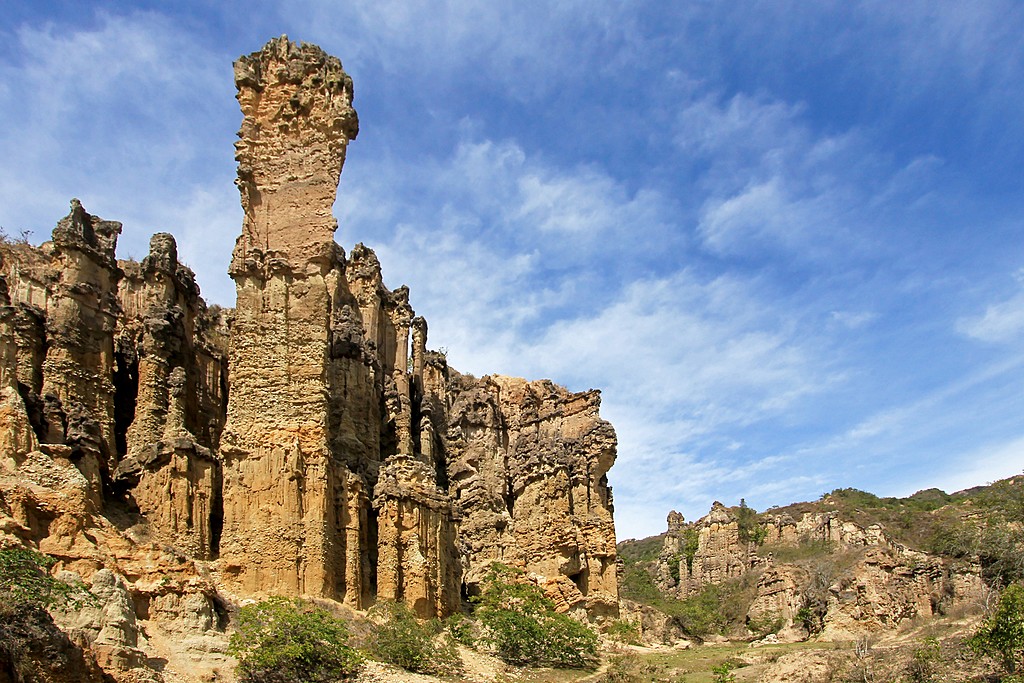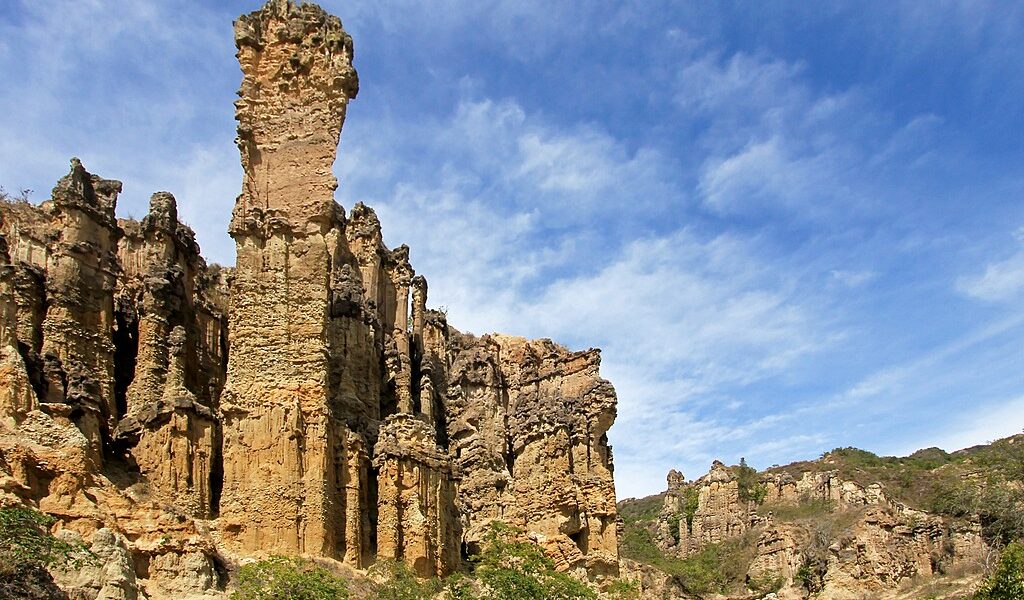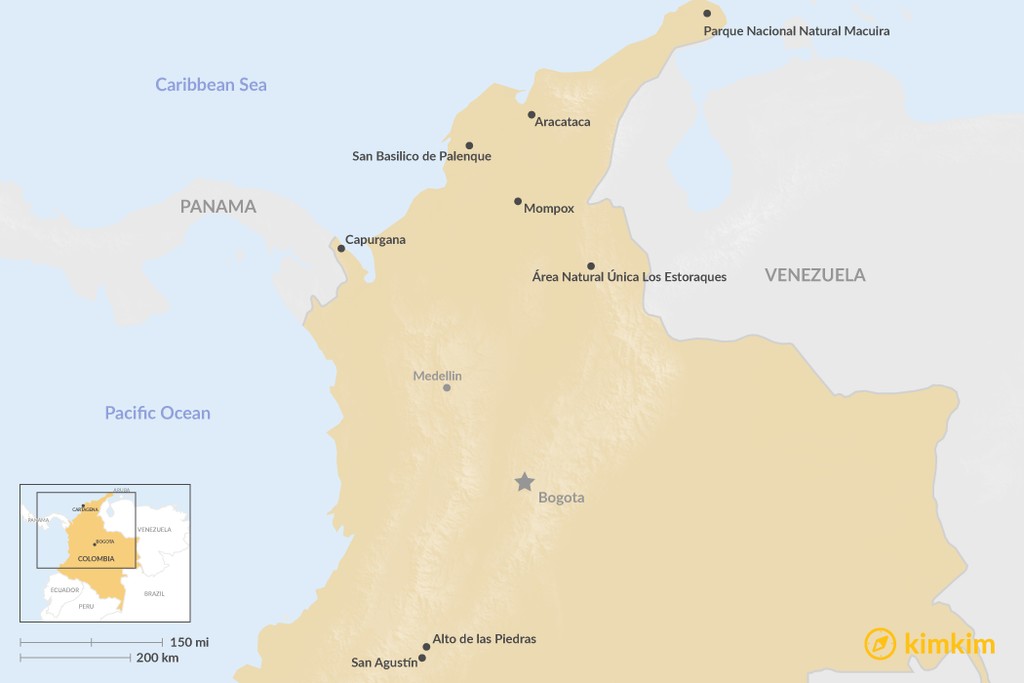
Colombia is a big country, and extremely diverse. It’s easy to find little-visited places of interest and intrigue tucked in the folds of the Andes or otherwise off the well-trodden path. Some are in areas that have only recently become safe to visit, such as Área Natural Única Los Estoraques. Others, such as Mompox or Capurgana, simply require a bit of planning to get to. The following 7 cool places are well worth seeking out to escape the masses.
## Unveiling Colombia’s Hidden Treasures: Beyond the Tourist Trail
Colombia, a land of vibrant culture, breathtaking landscapes, and a rich history, offers a plethora of experiences that extend far beyond the well-trodden tourist paths. Once you’ve ticked off the iconic landmarks and must-see attractions, it’s time to venture off the beaten track and delve into the heart of this captivating nation. Prepare to be amazed by the funky, fun, and fascinating places that offer a glimpse into the authentic soul of Colombia, revealing treasures that many travelers often overlook.
Did you know, for instance, that Colombia boasts landscapes reminiscent of the Sahara Desert? Or that hidden within its borders lie colonial villages that whisper tales of a bygone era? These are just a few of the surprises that await the adventurous traveler. Furthermore, the historic 2016 peace agreement between the Colombian government and the FARC (Revolutionary Armed Forces of Colombia) guerrillas has ushered in a new era of accessibility, opening up destinations that were previously considered too risky to visit. This newfound peace has unveiled a world of opportunities for exploration and discovery, allowing travelers to immerse themselves in the beauty and diversity of Colombia like never before.
Whether you’re a devoted fan of the literary genius Gabriel García Márquez, eager to trace the footsteps of his iconic characters, or a curious explorer seeking a yet-to-be-discovered colonial village brimming with charm and character, this curated list promises something to ignite your adventurous spirit. Embark on a journey of discovery and uncover the hidden gems that make Colombia a truly unforgettable destination.
## Delve into the Ancient Mysteries of San Agustín’s Pre-Columbian Megaliths
For those with a passion for history and archaeology, the mountains of the Huila department offer a veritable treasure trove of pre-Columbian historic sites that are sure to captivate and intrigue. Declared a UNESCO World Heritage Site, this remarkable area is home to an extraordinary collection of over 500 caryatids, totems, and other monumental stone statues, forming the largest group of megalithic sculptures in all of Latin America. Each sculpture tells a silent story, offering a glimpse into the beliefs, rituals, and artistic prowess of the ancient civilizations that once thrived in this region.
Centered around the charming town of **San Agustín**, these awe-inspiring sculptures are strategically dispersed across various sites on the _mesetas_ (plateaus) that flank either side of the upper Magdalena valley. The main site, **Parque Arqueológico Nacional de San Agustín**, serves as a gateway to this ancient world, featuring a well-curated museum and four distinct concentrations of statues. Located immediately west of town, this park provides a comprehensive introduction to the region’s rich archaeological heritage.
However, to truly appreciate the scale and significance of these megalithic wonders, be sure to venture beyond the main site and explore the more remote locations, such as **Alto de Los Ídolos** and **Alto de las Piedras**. For an even more immersive experience, journey further afield to **Parque Arqueológico Nacional Tierradiento**, nestled in San Andrés de Pisimbalá, where you can explore underground tombs meticulously carved into the granite earth. To add an element of adventure to your historical exploration, consider combining your visit with an exhilarating whitewater rafting excursion on the majestic Río Magdalena, allowing you to experience the natural beauty of the region from a unique perspective.
## Unwind and Recharge in the Afro-Colombia Beach Village of Capurgana
While the sun-kissed sands surrounding Cartagena and the idyllic island of San Andrés typically draw the majority of Colombia’s beach-loving travelers, the quaint Afro-Colombian fishing village of Capurgana offers a tranquil escape from the bustling crowds, allowing you to reconnect with nature and immerse yourself in a slower pace of life. This remote and laid-back Caribbean haven, nestled on the western shore of the Golfo de Urabá, is a landlocked paradise accessible only by boat from either **Turbó** or **Acandi**. The journey itself is an adventure, offering stunning views of the coastline and a sense of anticipation as you approach this hidden gem.
Upon arrival, you’ll be greeted by a breathtaking panorama of sand-fringed bays, turquoise Caribbean waters, and the lush, jungled backdrop of the **Serranía del Darién** mountain range. Beyond simply lazing beneath the swaying coconut palms (be mindful of falling nuts!), there’s a wealth of activities to enjoy on these pristine shores. The reef-protected **Playa La Caleta** is an ideal spot for snorkeling, allowing you to explore the vibrant underwater world teeming with colorful marine life. Local operators in Capurgana offer a range of excursions, including scuba diving, rainforest hikes, and horseback rides, providing opportunities to discover the diverse ecosystems that surround the village. For a truly meaningful experience, consider volunteering at the nearby marine turtle reserve at **Sanctuario de Fauna Acondí, Playon y Playona**, contributing to the conservation efforts that protect these magnificent creatures.
## Be Awestruck by the Surreal Landscapes of Área Natural Única Los Estoraques
The Norte de Santander province, during the 1980s and 90s, unfortunately became a stronghold for FARC and ELN guerrillas, making travel to the region a risky endeavor. However, times have changed, and today, this area welcomes visitors with open arms, eager to share its natural wonders. You may still find yourself among the few international travelers to marvel at the stupendous rock formations within **Los Estoraques Unique Natural Area**, a geological marvel that rivals the iconic Bryce Canyon in Utah. This breathtaking landscape features red sandstone cliffs sculpted by the relentless forces of wind and rain into fantastical pillars, creating a surreal and unforgettable panorama.
Accessible via Ocaña, the reserve lies just south of **La Playa de Belén**, an exquisitely preserved colonial village that has been rightfully designated a National Heritage town. From La Playa de Belén, the park is clearly signposted, guiding you towards the entrance. Well-maintained trails wind uphill from the ranger’s booth, leading you through gullies and beneath dramatic rock formations. As you explore, be mindful of your surroundings, as venomous snakes can be found in the area. Remember to pack plenty of water and sunscreen, as the sun can be intense in this exposed landscape.
The charming pueblo of La Playa de Belén is well worth an overnight stay, allowing you to fully appreciate its unique character. Every house is adorned with hanging planters and painted in a striking combination of white with rust-red-trim bases and chocolate-painted old wooden window grills, creating a visually stunning and harmonious aesthetic.
## Step Back in Time in the Historic Town of Mompox
In the tranquil town of Santa Cruz de Mompox, located approximately 85 miles (136 km) southeast of Cartagena, time seems to have stood still for the past two centuries. Founded in 1539 on the banks of the Río Magdalena, Mompox flourished as a vital river port, serving as the main link between Cartagena and the Andes. However, in the 19th century, the river’s course shifted, leaving Mompox isolated and seemingly forgotten in the heart of a bayou. Reaching Mompox requires careful planning and a spirit of adventure, as the journey itself is an integral part of the experience. The creaky ferry that navigates the river and the inky black lagoons of the swampy floodplain provides a unique and memorable mode of transportation.
Today, the town, weathered by humidity, resembles a meticulously crafted Hollywood stage set, where locals move with a timeless languor. This UNESCO World Heritage City boasts an impressive collection of fine churches and elaborate mansions, many of which have been recently transformed into chic bars and boutique hotels. Be sure to stroll along Calle Real del Medio, lined with silversmiths’ workshops (_talleres de filagría_), where skilled artisans continue to practice the ancient art of filigree jewelry making.
While Mompox offers a wealth of historical and cultural attractions, including the Iglesia de Santa Barbara, the Museo Cultural de Arte Religioso, and the fascinating necropolis, its true charm lies in the slow-paced street-life. As you wander through the town’s streets, you’ll be transported to a world reminiscent of Gabriel García Márquez’s fictional and surreal Macondo. In fact, Mompox served as a setting for several of his novels, its atmosphere and characters inspiring his magical realism style.
## Uncover Unique Ecosystems in Parque Nacional Natural Macuira
If you’re seeking to reconnect with nature far away from the crowds, adding a visit to the Serranía Macuria to your itinerary in La Guajira is an excellent choice. This compact mountain range rises dramatically from the desert of Alta Guajira, creating a striking contrast in landscapes. This remote park, situated at the northernmost point of **La Guajira**, is a biogeographical island – a lush oasis boasting diverse ecosystems, ranging from dry tropical forest to dwarf cloud forest at higher elevations.
The area is characterized by a high degree of endemism, with 17 out of 140 bird species found exclusively in Colombia, earning it recognition as an Important Bird and Biodiversity Area. Cerro Palúa stands as the park’s highest point, reaching an elevation of 2834 ft (864 m).
Numerous trails crisscross the park, although access to the cloud forest is restricted. The hike to **El Chorro waterfall** is highly recommended, offering stunning views and the chance to spot local wildlife. With a bit of luck, you might encounter monkeys, snakes, or even one of the two cat species that inhabit the area. Access to the park is gained through the community of Nazareth. Reaching Nazareth by 4WD can be challenging, particularly during the wet season (September-November), and the area has historically been prone to banditry. Therefore, it is essential to travel with a Wayúu guide arranged through a reputable tour operator.
## Follow the ‘Gabo’ Trail to Aracataca, the Birthplace of a Literary Legend
For devoted admirers of Nobel Prize-winning novelist Gabriel (‘Gabo’) García Márquez, a visit to Aracataca is akin to a pilgrimage to a sacred site. This sleepy town, where Gabo was born and raised, lies just 50 miles (80 km) south of Santa Marta, nestled in the heart of a banana-producing region. In many ways, Aracataca mirrors Macondo, the surreal village that served as the setting for Gabo’s seminal novel, One Hundred Years of Solitude.
The 14-room Casa Museo Gabriel García Márquez meticulously recreates his grandparent’s farmstead home, where he spent his formative years. His upbringing in this environment profoundly shaped his distinctive ‘magic realism’ style, and the rooms are thematically dedicated to his biographical novels. As you stroll through the center of town, you’ll encounter statues and eclectic mementos that pay homage to the characters and memorable moments from his literary works. Be sure to visit the Museo Telegrafo, which evokes the period of Gabo’s early life through its collection of rusty and dusty period miscellany.
Complete your literary journey with a delightful meal at El Patio Mágico de Gabo, a charming restaurant that doubles as a mini-museum, celebrating the life and works of this literary icon.
## Immerse Yourself in Afro-Colombian Culture in San Basilico de Palenque
Just a short one-hour drive from Cartagena, yet seemingly worlds away, nestled amid swampy terrain in the foothills of the Sierrita Montes de María, lies the small village of **San Basilico de Palenque**, a truly unique and historically significant community. Founded in the late 16th century by _cimarrones_ (runaway slaves), Palenque served as a fortified settlement for those seeking freedom from oppression. While the Spanish authorities suppressed other palenques, San Basilico uniquely secured its freedom in 1691. Today, the majority of the approximately 3500 inhabitants of this Afro-Colombian community are descendants of the original _cimarrones_.
Cartagena’s flamboyantly dressed _palenqueras_, known for their vibrant attire and captivating presence, originally hailed from San Basilico de Palenque. The community has diligently preserved many of its oral, musical, and other cultural traditions, ensuring that its unique heritage continues to thrive. Many residents still speak _palenquero_, a distinctive Creole dialect influenced by the Kikongo language of Angola and Congo. Recognizing its exceptional cultural value, UNESCO has designated San Basilico de Palenque a Masterpiece of the Oral and Intangible Heritage of Humanity. Plan your visit to coincide with the vibrant _Festival de Tambores_ (Drum Festival) in October, when the community comes alive with music, dance, and celebrations that honor its African roots.


